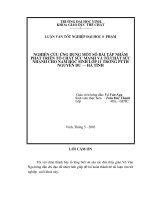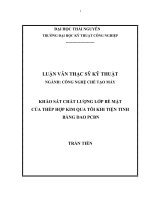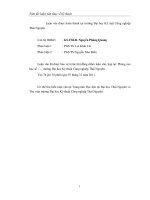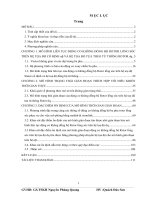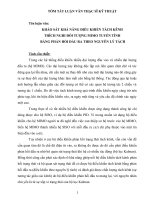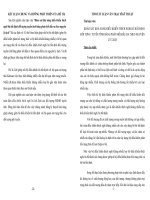(Luận văn thạc sĩ) nghiên cứu khảo sát về mức độ lo sợ khi học nói tiếng anh bằng phương pháp nghiên cứu hỗn hợp trên học sinh lớp 11 trường THPT thanh oai a
Bạn đang xem bản rút gọn của tài liệu. Xem và tải ngay bản đầy đủ của tài liệu tại đây (688.78 KB, 51 trang )
VIETNAM NATIONAL UNIVERSITY, HANOI
UNIVERSITY OF LANGUAGESAND INTERNATIONAL STUDIES
FACULTY OF POST – GRADUTAE STUDIES
BÙI THỊ MAI
A MIXED METHOD STUDY ON STUDENTS’ SPEAKING ANXIETY :
A SURVEY ON 11TH FORM STUDENTS
AT THANH OAI A HIGH SCHOOL
( NGHIÊN CỨU KHẢO SÁT VỀ MỨC ĐỘ LO SỢ KHI HỌC NÓI
TIẾNG ANH BẰNG PHƯƠNG PHÁP NGHIÊN CỨU HỖN HỢP TRÊN
HỌC SINH LỚP 11 TRƯỜNG THPT THANH OAI A)
M.A. Minor Program Thesis
Field
Code
: Engplish Teaching Methodology
: 60140111
Hanoi, 2016
IETNAM NATIONAL UNIVERSITY, HANOI
UNIVERSITY OF LANGUAGES AND INTERNATIONAL STUDIES
FACULTY OF POST-GRADUATE STUDIES
BÙI THỊ MAI
A MIXED METHOD STUDY ON STUDENTS’ SPEAKING ANXIETY :
A SURVEY ON 11TH FORM STUDENTS
AT THANH OAI A HIGH SCHOOL
( NGHIÊN CỨU KHẢO SÁT VỀ MỨC ĐỘ LO SỢ KHI HỌC NÓI
TIẾNG ANH BẰNG PHƯƠNG PHÁP NGHIÊN CỨU HỖN HỢP TRÊN
HỌC SINH LỚP 11 TRƯỜNG THPT THANH OAI A)
M.A. Minor Program Thesis
Field
: English Teaching Methodology
Code
: 60140111
Supervisor : Assoc. Prof.Dr. Lê Văn Canh
Hanoi, 2016
CERTIFICATE OF ORIGINALITY OF STUDY PROJECT REPORT
I declare that this thesis: “A mixed method study on students’ speaking anxiety:
A survey on 11th form students at Thanh Oai A high school ” is my own work
and effort and has not been submitted anywhere for any award. Moreover, the
contributions of my colleagues and students are involved. Other sources of
information have been used and acknowledged.
Hanoi, November 2016
Bui Thi Mai
i
ACKNOWLEDGEMENTS
I wish to show my sincere appreciation to the following people who
supported me to complete this study.
I wish to express my warmest gratitude to my respectful supervisor,
Assoc.Pro. Dr Lê Văn Canh , who instructed me how to do this research and
provided me with a lot of professional advice on the thesis writing. I am really
grateful to his generosity, kindness, and encouragement. Without his support, I
could have never been able to finish this study
I also would like to express my greatfulness to the participants of this studythe 11th form students and the teachers at Thanh Oai A high school for their wholehearted participation.
I feel a deep gratitude to my family. My thankfulness goes to my parents
who have patiently supported me to complete the research, and to my husband and
my children who have stood by me as a big supporter.
ii
ABSTRACT
Many studies in second language acquisition have examined language anxiety, but
few have explored its sources, especially in speaking skill. Therefore, this study was
designed to investigate potential sources of speaking anxiety viewed from and
manifested in 11th form students at Thanh Oai A high school . Through the use of
questionnaire and narrative frames as research instruments and some sources of
language anxiety as theoretical guideline for data collection and analysis, major
findings were drawn. First, the speaking anxiety tendency of the students surveyed
was obvious. Second, some sources leading to students’ speaking anxiety were
found. They include these factors as learners’ communication apprehension, test
anxiety and fear of negative evaluation. Based on the learner’s and teachers’
recommendations in questionnaire and narrative frames, the research proposes some
coping strategies to ameliorate negative effects of this kind of anxiety. It is hoped
that this research will help Vietnamese learners and teachers have a better
understanding of the nature of foreign language acquisition anxiety in general and
speaking anxiety in particular to improve the teaching and learning of English.
iii
LIST OF TABLES
Table 1: The results of the questionnaire about anxiety of speaking experienced by
the 11th form students in Thanh Oai A high school.
Table 2: Level of communication anxiety experienced by the 11th form students in
Thanh Oai A high school.
Table 3: Level of fear of negative evaluation experienced by by the 11th form
students in Thanh Oai A high school.
Table 4: Students’ feelings about speaking English in the classroom (N= 36)
iv
LIST OF CHARTS
Chart 1: The results of the questionnaire about anxiety of speaking experienced by
the 11th form students in Thanh Oai A high school.
Chart 2: the results for students’ responses about the item 1.
Chart 3: the results for students’ responses about the item 2.
Chart 4: the results for students’ responses about the item 3.
Chart 5: the results for students’ responses about the item 4.
Chart 6: the results for students’ responses about the item 5.
Chart 7: the results for students’ responses about the item 6.
Chart 8: the results for students’ responses about the item 7.
Chart 9: the results for students’ responses about the item 8.
Chart 10: the results for students’ responses about the item 9.
v
TABLE OF CONTENTS
DECLARATION……………………………………………………………………… i
ACKNOWLEDGEMENTS……………………………………………………….….. ii
ABSTRACT…………………………………………………………………..…….... iii
LIST OF TABLES………………………………………………………….……...…..iv
LIST OF CHARTS…………………………………………………………….……….v
PART A: INTRODUCTION ....................................................................................... 1
1. Rationale....................................................................................................... 1
2.Aims and objectives of the study................................................................... 1
3. Research questions....................................................................................... 2
4.Scope of the study ......................................................................................... 2
5.Methods of the study...................................................................................... 2
6.Design of the study ....................................................................................... 2
PART B: DEVELOPMENT ........................................................................................ 4
CHAPTER 1: LITERATURE REVIEW...................................................................... 4
1.1. Overview of speaking ............................................................................... 4
1.1.1. Definition speaking ..................................................................... 4
1.1.2. The role of speaking in language teaching and learning .............. 4
1.1.3. Principles of teaching speaking ................................................... 5
1.2. Foreign language learning anxiety ......................................................... 6
1.2.1 Definition of foreign language learning anxiety .......................... 6
1.2.2 Components of foreign language learning anxiety ........................ 8
1.2.2.1 Communication apprehension ........................................ 8
1.2.2.2 Test anxiety ................................................................... 9
1.2.2.3 Fear of negative evaluation ............................................ 9
1.3. Speaking anxiety research ....................................................................... 10
1.4. Sources of foreign language anxiety and speaking anxiety ....................... 12
CHAPTER 2- METHODOLOGY ............................................................................. 17
vi
2.1 Overview of current teaching and learning speaking at Thanh Oai A
high school ................................................................................................. 17
2.2The informants ............................................................................................ 18
2.3. The instruments ....................................................................................... 18
2.4. Procedures ............................................................................................... 19
2.5. Techniques of data analysis...................................................................... 19
2.6. Data analysis and findings......................................................................... 20
2.6.1. Level of speaking anxiety experienced by 11th form students
at Thanh Oai A high school ................................................... 20
2.6.1.1. Communication anxiety: ............................................... 21
2.6.1.2. Fear of negative evaluation: .......................................... 26
2.6.2 Narrative data ............................................................................ 30
CHAPTER 3: SUGGESTED IMPROVEMENTS .................................................... 33
3.1. Solutions related to the contents of the lessons ........................................ 33
3.2. Solutions related to learners’ communication apprehension ..................... 33
3.3. Solutions related to learners’ fear of negative feedback ........................... 35
PART C: CONCLUSION.......................................................................................... 37
1. Concluding remarks ................................................................................... 37
2. Limitations of the study .............................................................................. 39
3. Suggestions for further study ..................................................................... 39
REFERENCES .......................................................................................................... 41
APPENDICES............................................................................................................. I
APPENDIX A .............................................................................................................. I
APPENDIX B ............................................................................................................ II
vii
PART A- INTRODUCTION
1. Rationale:
English has become a useful and indispensable means for Vietnam’s integration
of our country into the world community. Learning English becomes a great
necessity for Vietnamese people. Especially, learning speaking gains a great stature
as the need of communication is paid much more attention. But getting students to
respond in classes is a problem that most ESL teachers face. The problem of that is
particularly acute with non major English students, who are generally considered to
be more reserved and reticent than the majored ones. The nervousness and anxiety
frequently seem to become particularly aggravated when students are required to
speak in front of their teacher and their classmates. MacIntyre and Gardner (1991),
for example, assert that "anxiety poses several potential problems for the students of
a foreign language because it can interfere with the acquisition, retention, and
production of the new language" (p. 86).
As a teacher of English at Thanh Oai A high school, from my own observation
and experience, I myself have noticed that my students often experience foreign
language anxiety especially in speaking skill. They are afraid of speaking in front of
the class, even when the teacher asks them to practice English in pairs or in groups;
many of them keep silent or have discussion in Vietnamese. While the students are
more confident with written tests, they always feel reluctant when being asked to
speak English and try to give answers as short as possible. Some students even
refuse to give any answers when assigned. Some of them admit that they cannot
find words to say and they always feel nervous and anxious when speaking English
with teachers.
In an attempt to reduce my students’ speaking anxiety so they can feel more
comfortable learning to speak English, I decided to conduct a study on the topic:
“A mixed method study on students’ speaking anxiety: A survey on 11 th form
students at Thanh Oai A high school”
2. Aims and objectives of the study:
1
The first aim of this study was to review the literature about foreign language
learning anxiety so that I can learn more about what has been known and what has
not been regarding the topic of speaking anxiety. This knowledge will help me to
design the appropriate intervention in my class with my students. Towards that goal,
this study was conducted to achieve the following specific objectives :
- to identify the levels of speaking anxiety and factors leading to that anxiety
among the 11th form students at Thanh Oai A high school
- to think of necessary measures on the basis of the results of objective 1 to help
the students to reduce their English speaking anxiety.
3. Research questions
In order to achieve the above-presented aims and objectives, the study was
designed to answer two following research questions:
1. What do the 11 graders at the researched school self-report on their levels of
anxiety in learning to speak English in the classroom?
2. What are the causes of their speaking anxiety?
4. Scope of the study:
The study limits itself to the survey of a group of high school students, i.e.,
graders, at Thanh Oai A high school. The type of anxiety that is investigated is the
anxiety that students experience in the English-speaking lessons taught at their
school within the current English language curriculum for high school students.
5. Methods of the study:
Since the purpose of the study is to gain understanding about the students’
level of English-speaking anxiety and the causes of that anxiety, the study is a
survey study. Two data collection instruments were used. These are the students’
questionnaires and narrative frames.
6. Design of the study:
The study consists of three parts:
2
Part A: Introduction: This part offers a brief introduction to the rationale
for choosing the topic, the aims and objectives, the scope, the methods and the
organization of the study.
Part B: Development
The part consists of three chapters, as follows:
+ Chapter 1: Literature Review
This chapter reviews the literature on language learning anxiety in order to
provide the theoretical background and the conceptual framework for the study.
+ Chapter 2 -
Methodology – provides information about the methods of
data collection that were employed in the study and the research procedure that the
study followed. This is followed by the presentation of the findings and the
discussion of those findings.
+ Chapter 3 – Suggested improvements for teaching and learning speaking
skill– focuses on anxieties facing students in learning speaking skill and suggested
techniques and activities for the teachers to improve their teaching, suggested
solutions for students to reduce and cope with anxieties facing them in speaking
classes.
Part C: Conclusion
This part offers an overview of the major findings as well as the limitations
of the study, the implications and suggestions for further research in this matter.
3
PART B: DEVELOPMENT
CHAPTER 1: LITERATURE REVIEW
The main aim of this chapter is to review the literature on second language
anxiety in general and speaking anxiety in particular. The chapter starts with a
literature review on anxiety. This is followed by an overview of speaking. The end
of the chapter is a discussion of speaking anxiety.
1.1 Overview of speaking
1.1.1 Definition of speaking
Florez (1999) defines speaking was “ an interactive process of constructing
meaning that involves producing and receiving and processing information.” (cited
in Balley, 2005:2). It is “often spontaneous, open-ended and evolving”, but it is not
completely unpredictable. In other words, “speaking consists of producing
systematic verbal utterances to convey meaning.” (Balley, 2005:2)
Bygate (1997) states that speaking was a skill which deserved attention every
bit as much as literacy skill. It is often thought of as a “popular” form of expression
that uses the unprestigious “colloquial” register. Speaking is in many ways an
undervalued skill. Perhaps this is because we can almost speak, and so take the skill
to much for granted. In his own view, Mackey (1965) defines “Oral expressions
involves not only the use of the right sounds in the patterns of rhythm and
intonation, but also the choice of words and inflections in the right order to convey
the right meaning.” (cited in Bygate, 1997: 5). According to him, for the students
who want to be good at speaking, he/ she has to choose the right forms, put them in
correct order, sound it like native speaker and even produce the right meanings.
Therefore, speaking skills generally have to be learnt and practiced carefully before
giving a presentation.
1.1.2 The role of speaking in language teaching and learning
Speaking plays an utmost important role among the four language skills
since it helps to identify who knows or does not know a language. Pattison (1992)
4
confirms that when people know or learn a language, they mean being able to speak
the language.
In language teaching and learning, speaking is a medium through which
much language is learnt, and which is particularly useful for learning. The ability to
communicate in a second language clearly and efficiently contributes to the success
of the learners in school and success later in every phase of life (Kayi, 2006).
More than this, speaking is regarded as the first step to confirm who knows
or does not know a language. Ur, P (1996) shows that people who knows a language
are referred to as “speaker” of that language as if speaking included all other kinds
of knowing.
To many language learners “ mastering the art of speaking is the single most
important aspect of learning a second language or foreign language, and success is
measured in terms of ability to carry out a conversation in the language”. (Nunan,
1991: 39). It can be inferred from Nunan’s view point that speaking is a very
important skill among the four basic ones. Therefore, having dealt with the
importance of oral skills in language teaching and learning is essential that language
teachers should pay more attention to teaching speaking skills. In order to carry out
many of the most basic transactions, it is necessary for learners to speak with
confidence.
1.1.3. Principles of teaching speaking
In order to have a successful speaking lessons, teachers and learners should
pay attention to its principles suggested in EST methodology II (To Thu Huong, et
at., 2008).
First of all, by learning to speak following given models students can imitate
the way native speakers use the languages and their intonation. Besides, when
people want to keep their conversation, they have to listen to others, receive what
partners say to produce new sentences, so it is also reception
5
Secondly, teachers ought to “give students practice with both fluency and
accuracy”. As being mentioned by Brown & Nation (1997), students must learn
both knowledge and the way native speakers use the language to speak well.
On the other hand, it is recommended to “provide opportunities for students to talk
by using pair work and group work, and limit teacher talk”. Pair work and group
work are good tools to encourage students to talk in the class, so it will reduce
teacher’s talking time easily.
Moreover, tasks planned should “involve negotiation of meaning”. By asking
for explanation or clarification, students can understand the speech and maintain the
talk for a long time.
Lastly, students have chances to communicate in various and unpredicted
topics related to the real life so that they are stimulated to talk in speaking lessons.
To conclude, these principles are not all, but they are more important than
others, so they are reviewed to help teachers and learners have good speaking
classes.
1.2. Foreign language learning anxiety
1.2.1. Definition of foreign language learning anxiety
In the nineteenth century, Darwin (1872) thought of anxiety as an emotional
reaction that is aroused when an organism feels physically under threat. At the
beginning of the twentieth century, Freud (1920) regards anxiety as akin to “fear”
or fright”. In later decades, Hilgard, Atkinson, & Atkinson (1971 cited in Scovel,
1991: 18) define anxiety as “ a psychological construct, commonly described by
psychologists as a state of apprehension, a vague fear that is only indirectly
associated with an object”. Scovel (1978: 134) specifies the above definition and
states that anxiety is associated with feelings of uneasiness, frustration, self-doubt,
apprehension, or worry. According to Horwitz, et al. (1986), anxiety is “the
subjective feeling of tension, apprehension, nervousness, and worry associated with
an arousal of the autonomic nervous system”
6
ForMacIntyre and Gadner (1991b), anxiety in general can be experienced at
three perspectives: trait anxiety, state anxiety, and situation specific anxiety. The
first considers anxiety as a general possibility trait that is relevant across several
situation. The second perspective is interested in the here- and-now experience of
anxiety as an emotional state. The third approach examines the specific forms of
anxiety that occur consistently over time within a given situation.
Foreign language anxiety is a universal phenomenon that has a significant
factor adversely affecting the language learning process. Gardner & MacIntyre
(1993, cited in Arnold 1999:59) refer to language anxiety as “fear or apprehension
occurring when a learner is expected to perform in the second or foreign language."
Scholars have studied anxiety and its effect on foreign language learning for
many years. However, “for all the work conducted in this area, many fundamental
questions remain unanswered” (Speilmann & Radnofsky, 2001). “Teachers have
long been aware of the fact that many of their students experience discomfort in the
course of language learning [yet] researchers have been unable to establish a clear
picture of how anxiety affects language learning and performance. (Horwitz and
Young, 1991: xiii). Alpert and Haber (1960) determined that anxiety could have a
beneficial or facilitative effect on student performance (as cited in Elkhafaifi, 2005:
208). In 1977, Kleinmmann’s (cited in Aida, 1994) study of Spanish-speaking and
Arabic-speaking ESL students found that facilitating anxiety was correlated with
students’ oral production of linguistically difficult (thus challenging) English
structures (e.g., infinitive complements and passive sentences). However, there was
no evidence that debilitating anxiety negatively influenced oral performance.
Spielman and Radnofsky (2001) concluded that anxiety has a detrimental effect on
language acquisition. Horwitz (2001) reiterated that the issue of understanding the
relationship between anxiety and achievement is unresolved.
A more detailed description of language anxiety was provided by Horwitz, et
al. (1986). These authors regarded communication apprehension, test anxiety, and
fear of negative evaluation as the conceptual building blocks for the description of
7
foreign language anxiety. Communication apprehension is considered as fear or
anxiety related to communicating with people. They suggested that the inability to
express one’s thoughts and ideas in the foreign language or the inability to
comprehend another person were potential sources of anxiety for language learners.
This view of languge learning anxiety is adopted for this study.
1.2.2. Components of foreign language learning anxiety
The findings by Horwitz et al. (1986), which were the most significant ones
and we consider language anxiety with relation to performance evaluation within
academic and social contexts, include 3 components: communication apprehension;
test anxiety and fear of negative evaluation.
1.2.2.1. Communication apprehension
Horwitz et al. (1986) defines communication apprehension as "a type of
shyness characterized by fear or anxiety about communicating with people.
According to McCroskey (1997), communication apprehension is as "an
individual's level of fear or anxiety associated with either real or anticipated
communication with another person or persons".
Daly (1991) presents five explanations in the development of communication
apprehension which can offer an insight into the issue of understanding what causes
language anxiety for EFL learners. In the first place, he explains communication
apprehension in terms of "genetic disposition" indicating that one's genetic legacy
may be a substantial contributor to one's anxiety. Later in 1997, McCroskey stated
the same that children seem to be born with certain personality predispositions
towards communication apprehension. Secondly, he explains it in terms of
reinforcement and punishment related to the act of communication. He asserts that
individuals who, from early childhood, are greeted with negative reactions from
others in response to their attempt to communicate develop a sense that staying
quiet is more highly rewarded than talking.
Communication apprehension obviously plays a large role in foreign
language anxiety. People who are apprehensive speaking in dyads or groups are
8
likely to be even in more trouble when doing so in a foreign language class, where
"in addition to feeling less in control of the communicative situation, they also may
feel that their attempts at oral work are constantly being monitored" (Horwitz et al.,
1986). This apprehension is explained "in relation to the learner's negative selfperceptions caused by the inability to understand others and make himself
understood" (MacIntyre & Gardner, 1989).
1.2.2.2 Test anxiety
Test anxiety, as explained by Horwitz et al. (1986), "refers to a type of
performance anxiety stemming from a fear of failure". Test anxiety is quite
pervasive in language classrooms because of its continuous performance evaluative
nature. Test - anxious students often put unrealistic demands on themselves and feel
that anything less than a perfect test performance is a failure. Students who are testanxious in foreign language class probably experience considerable difficulty since
tests and quizzes are frequent and even the brightest and most prepared students
often make errors. It is also important to note that oral testing has the potential to
provoke both test and oral communication anxiety simultaneously in susceptible
student.
1.2.2.3. Fear of negative evaluation
Fear of negative evaluation is defined as the apprehension about other's
evaluation, avoidance of evaluative situation, and the expectation that others would
evaluate one negatively (Horwitz et al. 1986). It iss broader in scope than the test
anxiety because it may occur in any social, evaluative situation such as interviewing
for a job or speaking in foreign language classes. In the language classroom, fear of
negative evaluation is likely to be manifested in a student's over concern with
academic and personal evaluation of his performance and competence in the target
language.( MacIntyre & Gardner, 1988). Like communication anxious individuals,
people who fear negative evaluation rarely initiate conversation and interact
minimally. Students who experience this anxiety tend to sit passively in the classes,
9
withdraw from activities that could increase their language skills and may even
avoid class entirely (Ely, 1986; Horwitz, Horwitz & Cope, 1986).
Although communication apprehension, test anxiety, and fear of negative
evaluation are useful for describing foreign language anxiety, Horwitz, et al. (1986)
suggested that foreign language anxiety was not merely the sum of these fears. They
consider foreign language anxiety as a distinct complex of self- perceptions, beliefs,
feeling and behavior connected with, and arising from language learning situations.
Foreign language anxiety is a form of situation specific anxiety: it is stable over
time but limited to the particular situations of language learning. Except the foreign
language anxiety defined by Horwitz, et al. (1986), the anxiety related to specific
language skills, such as writing, reading, listening and speaking are all situation
specific anxieties. The situation-specific anxiety is different from the state anxiety,
because it is the tendency to become anxious, rather than the real- time anxious
feeling. It is different from the trait anxiety, for it is limited to a specific type of
situation, rather than across a variety of different settings. MacIntyre and Gardner
(1991a) suggested that situation-specific anxiety can be seen as trait anxiety in a
given context.
In other words, FLA is the “fear” or “apprehension” occurring when a
student is required to perform in the second or foreign language. Anxiety refers to
an emotional state which can have both positive and negative influences, and which
fosters and facilitates or disturbs and impedes learning (MacIntyre, 1995). Anxiety
can harm learners’ performance in many ways such as not participating in the
activities or not using the language in public. In contrast, it can be helpful in some
ways such as keeping student alert and trying to make the necessary preparation
beforehand for the learning activities.
1.3. Speaking anxiety research
The anxiety associated with second language speaking performance is called
speaking anxiety. Speaking anxiety has been supposed to be the result of speaking
and has also been found to influence speaking.
10
Research on the affective factors in second language acquisition has been
mounting steadily for a number of decades because students are “physical and
cognitive, but primarily emotional, being” (Rogers, cited in Brown, 2007: 97).
“Among the affective factors influencing language learning, anxiety ranks high”
(Arnold, 1999: 59). The construct of anxiety has been recognized as one of the most
important predictors of foreign language performance.
MacIntyre (1999: 33) claimed speaking seems to be “the single most
important source of language anxiety”. Students have been found to feel most
anxious when they respond to the teacher or are singled out to speak in class (Liu,
2007). The predominance of the number of items related to speaking on instruments
designed to measure general foreign language anxiety also reflects the widely held
view of speaking being the most anxiety- provoking aspect of foreign language
learning for many students.
A great deal of foreign language anxiety research has centered on anxiety
with respect to specific classroom activities such as speaking and listening
suggesting that oral classroom activities are most problematic and anxiety
provoking for foreign language learners (Horwitz, et al., 1986; MacIntyre, 1995;
Price, 1991; Young, 1991).
Kitano (2001) looked at sources of speaking anxiety among 212 learners of
Japanese. According to him, a fear of negative evaluation as a personality trait and
self-perception of speaking ability in the target language are the two potential
sources leading to foreign language speaking anxiety.
Liu (2007) made an investigation into the factors contributing to student
anxiety in oral production and the strategies used by the students to cope with this
anxiety. The findings of the study revealed that anxiety was experienced by many
students while speaking English in class. There were several factors leading to
anxiety such as lack of vocabulary, low English proficiency and memory
disassociation. The researcher underlined the importance of the awareness of the
11
teachers with regard to the existence of anxiety among EFL learners and showed
empathy to them in class.
Tsiplakides and Keramida (2009) examined the characteristics of anxious
students in order to implement classroom interventions to reduce foreign language
speaking anxiety and provide teachers with strategies to cope with anxiety
stemming from students’ fear of negative evaluation from their peers and perception
of low ability. Fifteen students participated in the study and the researchers used
three techniques of qualitative data collection: semi-structured interviews, group
discussion and direct observation. The data analysis showed that six of those
students were experiencing English language speaking anxiety as a result of fear of
negative evaluation from their peers and perception of low ability in relation to their
peers. Having established the sources for English language speaking anxiety, the
researchers implemented the following classroom interventions to overcome it:
project work, establishing community and a supportive classroom atmosphere by
considering teacher-student relations, providing indirect rather than direct
correction, accepting the need for self-worth protection, employing teacher’s
immediacy and praise. The researchers also pointed out that oral production in a
foreign language is a potentially stressful situation for some students and therefore,
the teachers should help their students to overcome foreign language anxiety.
1.4. Sources of foreign language anxiety and speaking anxiety
It has been estimated that approximately one third of students learning a
foreign language experience some types of foreign language anxiety (Horwitz,
Horwitz and Cope, 1986). Research has shown that there are a number of ways that
learning a foreign language can cause anxiety for the language learners. The causes
can be broken down into three main sources: learners’ characteristics, teacher
characteristics and classroom procedures.
Learner characteristics that can cause foreign language anxiety include low
self-esteem, competitiveness, self-perceived low level of ability, communication
12
apprehension, lack of group membership with peers, and beliefs about language
learning.
Horwitz, Horwitz and Cope (1986) stated that anxious students often cite
speaking in the foreign language to be their most anxiety-producing experience.
This is part due to the fact that it is hard to be one’s self in the target language (i.e.
feelings of uncertainty and threats to the ego due to the unknown element of the
second language; as cited in Guiora et al., 1972), which can thus trigger anxiety.
The foreign language learners are put in the position of communicating something
that is meaningful to him/her without having sufficient command of the language to
do so. Self-aware language learners are confronted with the probability that people
will perceive them differently from the way they perceive themselves. Thus learners
can experience anxiety as a result of fear of experience of “losing oneself” in the
target culture.
Student beliefs about language learning can also be associated with anxiety
(Horwitz, horwitz and Cope, 1986; Horwitz, 1988; Price, 1991; Young, 1991).
Students can have unrealistic expectations as to how a person should perform in a
foreign language classroom; when those expectations are not met it can lead to
negative feelings about one’s intelligence and abilities. Young (1994) listed the
following role-related beliefs which have been shown to evoke feelings of anxiety;
it is necessary for the teacher to be intimidating at times; the instructor is supposed
to correct every single mistake made by the students; group or partner work is not
appropriate because it can get out of control; the teacher should do most of the
talking; and the instructor’s role is that of a drill sergeant.
Palacios (1998) found that the following student beliefs are associated with
anxiety: the feeling that mastering a language is an overwhelming task; the feeling
that one needs to go through a translation process in order to communicate in the
target language; the difficulty of keeping everything in one’s head; and the belief
that learning a language is easier at an earlier age. These are all faulty beliefs that
13
may cause the students to have unrealistic expectations about the language learning
process, and thus cause some anxiety.
As far as teacher factors are concerned, a judgmental teaching attitude
(Samimy, 1994) and a harsh manner of teaching (Aida, 1994) are linked to student
fear in the classroom. Palacios (1998) found the following characteristics of the
teacher to be associated with anxiety: absence of teacher support, unsympathetic
personalities, lack of time for personal attention, favoritism, a sense that the class
does not provide students with the tools necessary to match up with the teacher’s
expectations, and the sense of being judged by the teacher or wanting to impress the
teacher. Young (1999) noted that teaching too much grammar or avoiding grammar
altogether as well as using speaking activities that put the learner “on the spot” in
front of peers without allowing prior preparation are also sources of anxiety for
many students. Ando (1999) found that having a native speaker for a teacher can
cause anxiety, as the teacher may lack the sensitivity of the learning process or the
teacher may be hard to understand in English.
A third source of foreign language anxiety is classroom procedures. Young
(1990) compiled a list of classroom activities which are perceived by students as
producing anxiety: (1) spontaneous role play in front of the class; (2) speaking in
front of the class; (3) oral presentations or skits in front of the class; (4) presenting a
prepared dialogue in front of the class; and (5) writing work on the board.
Error correction also turned out to play an important role: being negatively
evaluated by either the teacher or peers is often associated with anxiety. Palacios
(1998) found the following classroom characteristics to be anxiety-producing:
demands of oral production, feelings of being put on the spot, the pace of the class,
and the element of being evaluated (i.e. fear of negative evaluation).
Oxford (1999) emphasized learning and teaching styles as a potential source
of language anxiety. If the instructor’s teaching style and a student’s learning style
are not compatible, “style wars” can trigger or heighten anxiety levels.
14
In addition, language testing may lead to foreign language anxiety (Young,
1991; Daly,1991). For example, difficult tests, tests that do not match the teaching
in class, and unclear or unfamiliar test instructions can all produce learner anxiety.
In short, there are various causes of anxiety. In the context of speaking
English as a second language, Young (1991) listed six potential causes of language
anxiety which include both personal and interpersonal factors, learners’ beliefs
about language learning, instructors’ beliefs about language teaching, instructorlearner interactions, classroom procedures and language tests. However, to date,
findings by Horwitz, et al. (1986) have been the most influential. They identified
three causes of language anxiety, that is, communication apprehension, test anxiety
and fear of negative evaluation. Based on these three components they also
designed a Foreign Language Classroom Anxiety Scale comprising thirty-three
items. This scale was later used widely by researchers to measure foreign language
learners’ anxiety and examine the effect of anxiety on learning in different contexts.
Most studies on foreign language anxiety are quantitative in nature. From a
qualitative perspective, Price (1991) interviewed highly-anxious students to gain
insight into the subjective experience of language anxiety. In general, the interviews
were consistent with the foreign language anxiety construct identified by Horwitz,
Horwitz and Cope (1986). The participants spoke about their test anxiety,
communication apprehension, and fear of negative evaluation. All of them
identified speaking target language to be the greatest source of anxiety. Just like
Young (1990), the interviews conducted by Price emphasized the importance of low
self-esteem. Many of her subjects compared themselves to other language learners
and believed their language skills to be weaker. In addition, the participants’
responses suggested that perfectionism is another personality trait that can come
into play (cited in Gregersen and Horwitz, 2002). According to Price (1991),
anxious learners often engage in self-comparison with classmates and peers – a
practice which can lead to anxiety.
15
To sum up, the chapter reviews the literature on many issues related to
anxiety and speaking anxiety. These include a definition of foreign language
anxiety and its types, definition and the role of speaking in language teaching and
learning, principles of teaching the skills, factors causing speaking anxiety and
previous studies related to language anxiety in speaking skills. This knowledge,
therefore, serves as a basis for further work in the latter chapters.
16

